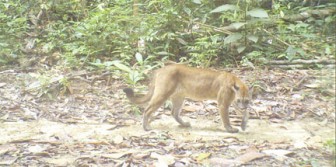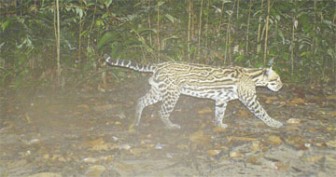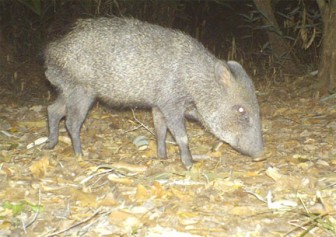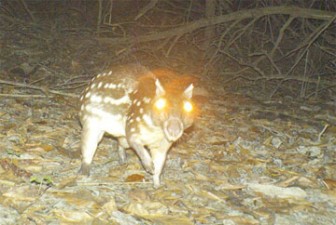If you have been following this series, you will have noticed that some of the photos feature an animal in side profile and the date and time the photo was taken shown in the bottom left hand corner. In many cases, it appears as if the animal was going about its regular business and does not seem aware that a photographer has just snapped its photo. That is because the photo was taken passively using a camera trap; instead of a person hiding in a blind to take the photo, cameras are strategically placed near key resources (water, food) or in areas where signs of animals have been found in the past. Cameras placed in the field are fixed to a tree and the shutter is triggered when an animal crosses the infrared motion sensor. Modern-day camera traps usually consist of a digital camera in a waterproof, shock-proof housing and provide 24-hour coverage of survey sites without the necessity of human presence to collect data.
The camera trap has been around as early as the start of the 1900s and was first used to document unconfirmed species on the island of Barro Colorado after the flooding of the Panama Canal. However, it wasn’t until camera traps were utilized to study tigers in India in the 1980s that it became a commonly used tool in wildlife research. This passive survey tool provides researchers with an advantage for studying rare or elusive species because they do not carry a scent or make noise like people in the field. Additionally, capturing only a photograph of the study animal eliminates the risk of injury to both researchers and their study animal, an advantage over previous studies where animals are physically captured. Camera traps can be used to determine the presence or absence of a particular species, the number of species in an area (species richness), how common or rare a species is relative to other species in a defined location (relative abundance) and activity patterns of a given species. For species where you can identify individual animals–spotted cats like Jaguars each have unique spot patterns–you can even estimate population size.

Camera traps have been used in the Iwokrama Forest and North Rupununi Savannah to survey Tapir (Bush Cow). This first exercise was used to test the suitability of this research tool for the region and attempt to document the habitat preference of Tapirs. The traps proved quite effective and captured a number of Tapirs along active trails to waterways. More recently, with assistance from the World Wildlife Fund, Iwokrama has continued its camera trap research studies and was looking at the distribution of Jaguars within a portion of the Iwokrama Forest; thirty pairs of cameras were set out along trails, logging roads and survey transects. The cameras captured six individual jaguars, four males and two females, in a study area of approximately 100 km2. In addition to Jaguars, the camera traps also captured many images of Puma, Giant Anteater, Ocelot, Powis, Grey-winged Trumpeter, Collared Peccary, Giant Armadillo, and unsuspecting humans walking in the surveyed area.

A number of organizations have conducted camera trapping projects in Guyana and the data collected have documented the amazing diversity and abundance of Guyana’s natural resources. Conservation International conducted a camera trapping study in the Essequibo Conservation Concession, revealing the importance of conserving that area. Panthera, an organization that works to develop conservation strategies for the world’s largest cats (including Tigers, Lions, Snow Leopards and Jaguars), has supported Jaguar research using camera traps in the Karanambu and Dadanawa areas resulting in some incredible photos of Jaguars, Puma and a wealth of other biodiversity. A separate and ongoing camera-trapping project is being conducted in the Kanaku Mountains (Region 9) by a researcher from Miami University’s Institute for the Environment and Sustainability and preliminary results from that project are showing a high level of species diversity and abundance in what is one of Guyana’s newest protected areas. These projects are serving as more proof of Guyana’s amazing resources and will contribute to the conservation and management of these areas into the future.

All camera trap photos for this article and series have been the result of research conducted by Iwokrama, Panthera and Miami University, and demonstrate how this excellent tool allows researchers to get valid information about population, diversity and use of areas by a myriad of animals right in our backyard. This information can then be used to determine monitoring and management plans for the animals in question.
Rain forests are rich in biodiversity and are home to many different plants and animals as well as indigenous communities.
Humans, even those who don’t live in the rain forest, rely on it for resources such as building materials (wood and lianas), medicine and fruits.

Rain forests also provide essential environmental services for life on earth; they create soil as well as prevent soil erosion, produce oxygen through photosynthesis, maintain clean water systems, and are a key defence against climate change.
The Iwokrama Rain Forest is 371,000 hectares, located in the heart of Guyana. Our mission is to develop strategies for conservation and sustainable development for local people in Guyana and the world at large.
We are involved in timber, tourism and training. Come and visit us in the rain forest or at http://www .iwokrama.org.





